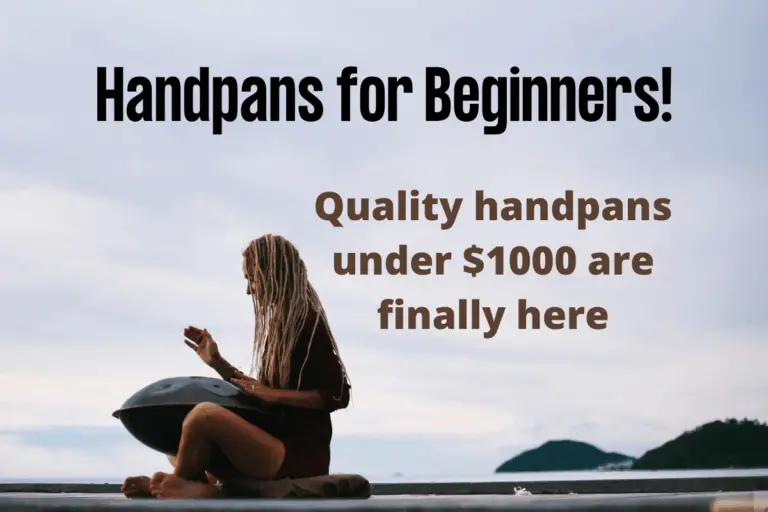Handpan Lessons – Learn to Play in 20 Hours
Learning to play the handpan does not have to be hard. You’ve got your new handpan, you’ve already played it a bit to get a feel, now is the time to consider some handpan lessons for beginners.
Is handpan hard to learn? – Learning to play a handpan is not hard as there are fewer notes to play than most other instruments. Add to this the scales used, and it is difficult to hit a bad note. A basic sense of rhythm will be helpful but handpan lessons are inexpensive and very accessible. You can become a good handpan player very quickly.
This guide will demonstrate just how quickly (20 hours is all you need – see below) you will be able to learn to play your first handpan using the correct approach, methods and available tools.

If you want to skip to the business, I recommend this excellent course of handpan lessons from Master The Handpan to get you playing like a pro in no time at all.

How Long Does it Take to Learn to Play Handpan?
Becoming a ‘good’ handpan player can be achieved in as little as 20 hours of practice. Surprising to some, if you learn and practice in the right way, and take some handpan lessons for beginners, those 20 hours will be the most important time of your handpan playing life.
You don’t even need the own the best handpan.
If you can put just 45 minutes aside each day to invest in learning to play your handpan every day for just one month you will be astounded at what a good handpan player you will become in such a short time.
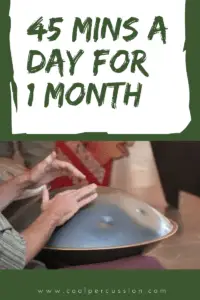
If you don’t believe that is possible. Just take 11 minutes out to watch this video from Josh Kaufman for tedTalkswhich debunks the age old 10,000 hours theory and proves 20 hours isn’t sufficient to become good at what you practice. It starts around the 8 minute mark.
That’s not to say that after just 20 hours of practice you will one of the best handpan players in the world, but you will be astounded by the progress you have made and what an accomplished handpan player you have already become in such a short amount of time.
Learning the Notes on a Handpan
No handpan lesson is going to teach what notes are on your handpan, I presume you already know this. However, if you for any reason you don’t know, it is probably worth finding out.
Typically the notes will be set out in the format as below, with the pitch ascending in order of the numbers, positioned left to right, from back to front [as you play]
The image is just one scale example of dozens available.

It is easy to find out what notes you have on your handpan by using an inexpensive digital tuner. You can identify each note, whilst at the same time checking to see if any are out of tune.
Out of tune notes will not help you in the process of learning to play your instrument.
Once you know which notes you have, you should be able to determine the scale. (Again, only if you don’t already know)
If you have yet to buy your first handpan, you may be considering which handpan scale is right for you. My ‘Which handpan scale should I choose’ article will help you some of the way.
Alternatively, I have a complete guide to handpan scales which is under construction and growing all the time.
Essential Handpan Lessons
There are a few fundamentals to consider before you start learning your handpan.
- How to position yourself
- How to position your handpan
- Use your lap or a stand
- Where to strike the notes
PRO TIP: Starting off on the right foot will prevent you from getting into bad habits that are easily picked up as you first begin to play.
A good example of this would be a self-taught guitarist who fingers chord with the incorrect fingers. Easy chords will be achievable, but by the time they begin to learn trickier chords to play, they find it difficult to achieve them cleanly thanks to bad habits picked up.
Good Handpan Playing Techniques
Muscle memory is as hard to teach out of a bad player as the teaching correct techniques are. If you constantly play a bad technique, it may sound ok at the start, but later down the line you will find it hard to progress.
Your handpan playing position
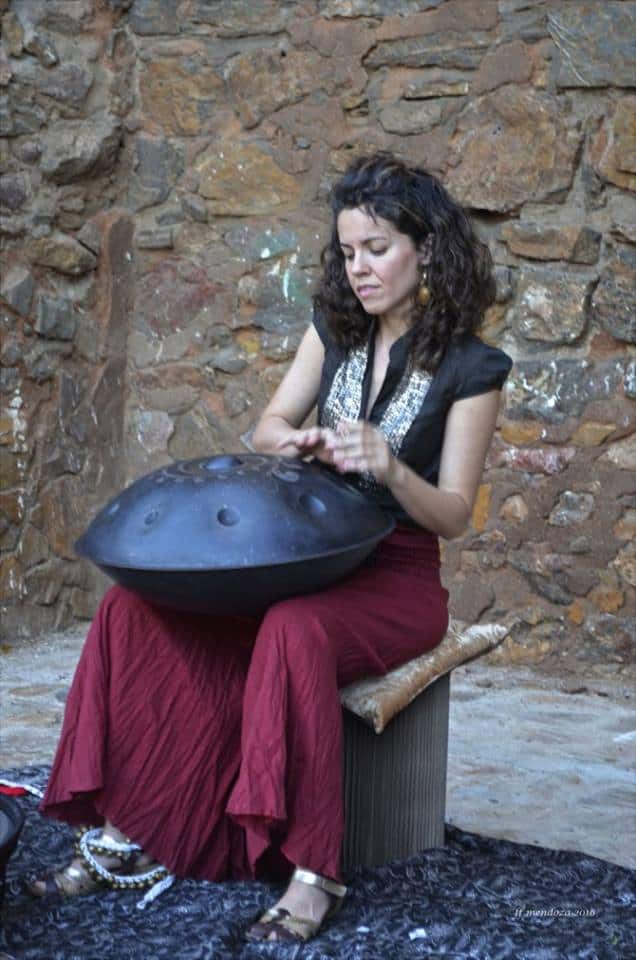
Most commonly you will find players in a sitting position playing a handpan. But it also possible to play handpan standing up.
This will ultimately come down to your personal preference or circumstance of where you are practicing or playing.
Handpan Position – Front or Back?
This is more interesting. One question I see very often regarding the playing position of the handpan is
Which is the front or back of a handpan? – You may be surprised to find this is a big enough subject to have a complete guide to which way round to play your handpan – Check it out
Should you play Handpan on Your Lap or Handpan Stand?
Again this is personal choice or circumstance. The cheapest option is, of course, playing handpan on your lap. However, you may prefer playing standing up, or may not be able to get comfortable enough to play for periods of time whilst sitting.

In which case you might want to consider a handpan stand option.
If you are thinking of buying a handpan stand, tread carefully. There are some very expensive options out there which will provide you with no more than far cheaper options available.
There are dedicated handpan stands, but also snare drum stands are commonly used. If choosing the latter I would suggest this lightweight aluminum snare stand from Amazon [check price] – It is light enough for portability but also has enough weight to provide a really solid base for your handpan to stand. It also has height adjustment to suit sitting or standing play. And it comes at under $100
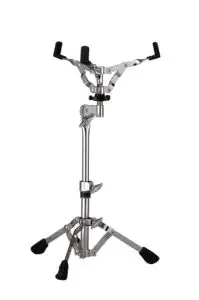
For more options on a stand for a Handpan, I have a full Recommended Handpan Stands Page
Beginning to Play & Striking Notes
The real fundamental to how to strike the handpan is to imagine it is too hot to touch. As if you were testing the bottom of a clothes iron to see if it were hot.
A dab of the thumb or the finger, releasing immediately you have struck the instrument is going to release the most resonance and not mute the note.
Of course, muting will become a part of you playing as you exercise more advanced handpan playing techniques but for now, just begin with these simple dabbing motions
I will refer back to the Essential Handpan Playing course from Master The Handpan – There are lots of lessons both in the beginners course and the more advanced courses as you progress, as to how to develop your striking techniques and the different sounds you can achieve with minor variations
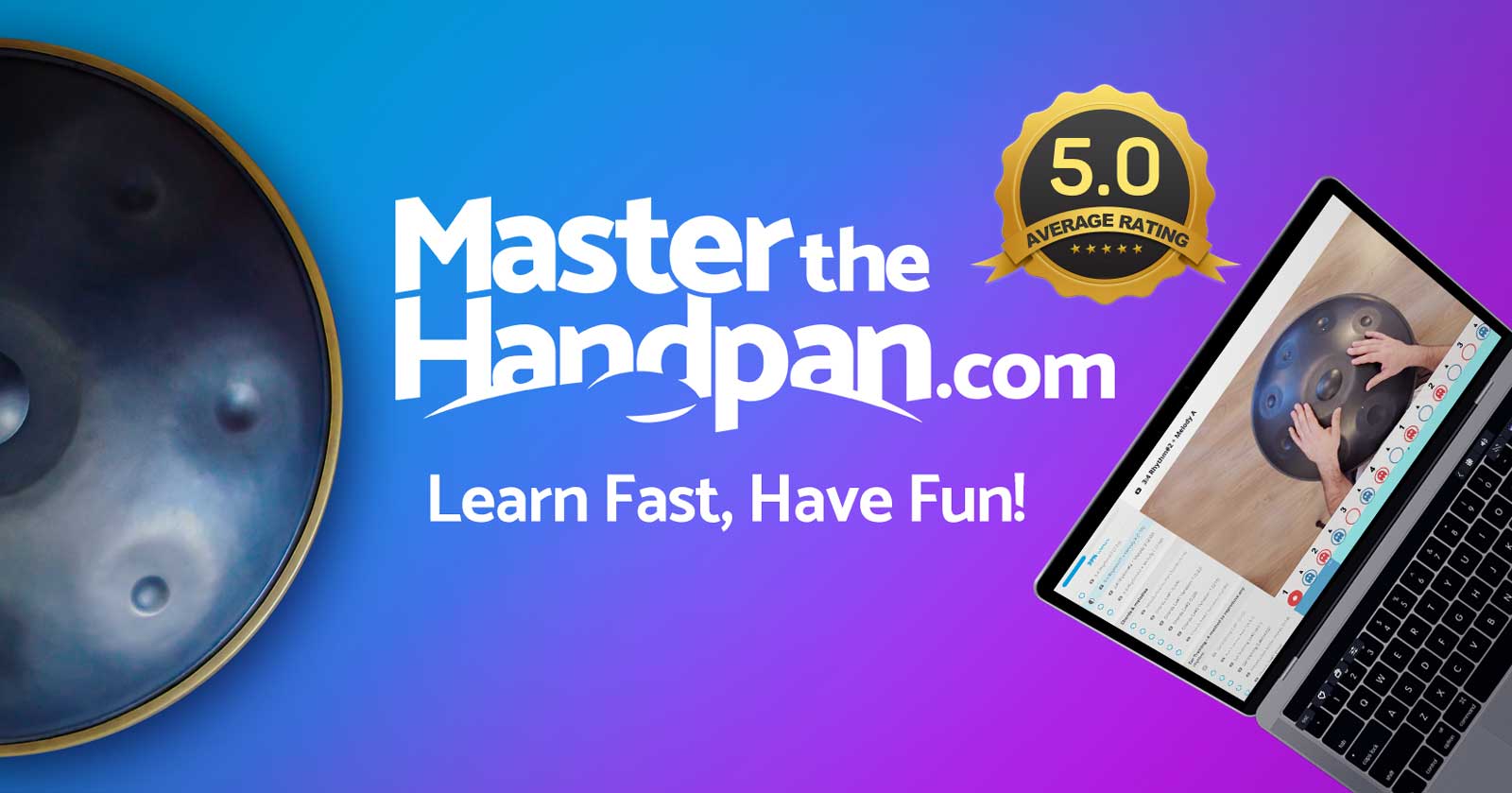
Learn basic rhythms on a handpan
The most common rhythm in music is the 4/4 rhythm or time signature. This is the rhythm you will most often here in general music you might listen to. It is a great start
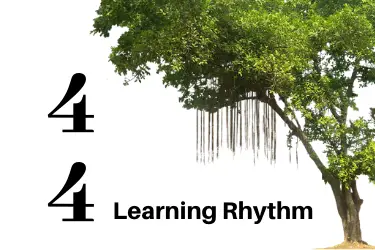
Developing the skill of being able to play a basic rhythm on your handpan, will help you progress in your learning.
What is the importance of rhythm in music? – Rhythm can play a crucial role in keeping a tune or melody flowing along within a song. It dictates the pace of the music, slow or fast, and the ‘feel’, the ‘groove’, the ‘meaning’. Being able to alternate rhythms can also produce drama and effect within a composition.
Access this lesson and 72 further video lessons to learn at your own pace with the Essentials – Beginner handpan course
In ambient and experimental music, which the handpan instrument certainly falls within it is also possible to create arrhythmic music.
Before really being able to master that though, you need to understand rhythm and be able to play some basics
To discover what time is look well at music, for in music, time is exactly measured and defined with rhythm and soul.
Scott E Shjefte
Once you have picked up some basic rhythms and practiced a little bit, you will be in a position to experiment between lessons and apply what you have learned to try different note progressions
How Alternate Hand Technique Can Improve Your Playing
Being able to play your handpan with both hands, in an alternate fashion with each hand working independently of the other, might be something that you will have to practice a little more.
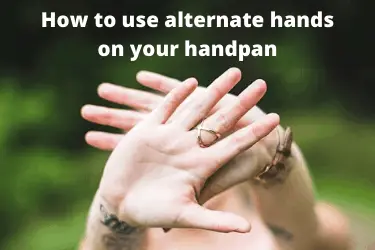
You will have a dominant hand, whether that be left or right, and some training for your non-dominant side. You can do this by reversing some exercises. It will be worth the effort.
If you have ever played percussion before, or specifically drum, or even if you have ‘air-drummed’ along to Phil Collins at some point, you may have some basic alternate and independent hand coordination, which will help.
You will learn some basic alternate hand techniques in rhythm lessons. Starting with 4/4 rhythms you will get used to playing, left, right, left right. From there you can develop different rhythms and beats and improve your technique to produce more complicated rolls.
Using rudiments to improve your alternate hand technique
Once you begin to play melodies, or even construct your own tunes and want to show them off to friends and family, this is when a weakness in one hand or the other will come to prominence.
Using rudiments can help overcome this imbalance. Ultimately it is only the brain instructing your hands that one is better than the other. The job at hand now is to convince your brain that they are equal.
1 Weird Trick Will be your Best handpan Lesson Ever – And you won’t even need a handpan!
Now, get ready for something totally mad!
Start shaving with your less dominant hand, or brush your hair or teeth this way.

It is almost instinctive to use your dominant hand for these thoughtless tasks each day. Switch it up! It will be tricky, to begin with, but within a few days, if you keep at it, Your brain will make the connection and realize it has to send better signals to this hand which is now undertaking a task it never did before.
Within a week of undertaking this simple task for just a minute a day will have your less dominant hand catching up with the ability of the dominant one.

Being able to play equally in terms of striking technique speed and movement is essential in becoming better than average handpan player. And to learn this basic lesson as a beginner will provide you with a smoother transition to trickier techniques as you improve.
If you are feeling really brave, try creating a melody with your dominant hand and once you have got it down, switch to using the other hand. it will be tricky and feel alien, to begin with, but keep going until you can play it with the same confidence as you did with the first. It won’t take long I promise.
Playing Chords -Striking 2+ Notes at the Same Time. When?
Chords created by striking 2 or more notes simultaneously can and will sound awesome and provide real depth to the tunes you create on your handpan. A beginner can find and play beautiful sounding chords right from the start.
It is just a matter of exploration, and no handpan lessons are required to find them. Perhaps how to use them, yes, but for now, take a look at this video.
Most handpans purchased by beginners will have 7,8 or 9 notes. If you happen to have an instrument with more notes, you have more chord variations to explore and discover.
I’m excited to say I currently have a variation of this handpan on order, and can not wait to discover the possibilities with it.
Experiment with playing chords on your handpan
The best way to find chords on your handpan is to experiment with playing two or more notes, with one or both hands at the same time and have a listen. Don’t worry about the name of the chords or what Key you are achieving. your ear will tell you if it works or not.

If it doesn’t sound good to you, it won’t sound good to your audience. If it does, then try to remember it, and experiment with popping it into your tune.
It may be that you can play a chord that doesn’t sound great or creates a bit of tension for dramatic effect in places, but I would suggest trying that out is a more advanced technique, and not necessary at all.
Controlling the volume of the notes
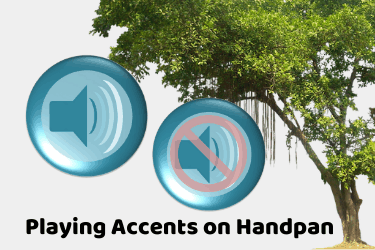
Something you may come across in handpan lessons is ‘accents’. Basically playing an accent in music on pretty much any instrument is the technique of creating emphasis on a note. Stronger, softer, shorter and longer are some basic examples, and the easiest to use to explain.
I am going to use another video for an example to playing accents within a song this time.
They are subtle and really well used in this composition that went into my favorite handpan tunes as soon as I came across it. The accentuated notes [Accents – see!] are used really well in this video
Best Way to Learn Handpan
While you can play your handpan on your own and learn as you go along, I am sure you will have seen from all of the sections above, that gaining some basic fundamental instruction from the start will help you progress and become a better player in just 20 hours.
It is fun, and irresistible to grab your handpan the moment you get your hands on it and start playing.
Indeed, I encourage you to take that pan and get acquainted as soon as possible. Connect with it, feel it, become one. You will quickly find your way around it, and due to the uniqueness of the handpan instrument, you will be able to create some wonderful sounds without a single lesson.
But it is important if you want to develop into a good handpan player, to take at least a beginner’s course of lessons. just to cover off the most basic techniques to discover that your handpan can give you so much more than you can discover on your own.
That’s why I recommend the Master The Handpan Essential Beginners course in handpan lessons.
Admission of Failure
Actually, it’s not a failure, it is a lesson. I was a staunch believer that I wanted to connect with my handpan and learn MY WAY of playing it. And whilst I have done so on and off for many years and can play some good tunes that I am happy with for meditation or just fun I was missing out.
Thanks to meeting David Charrier of Master The Handpan and taking the Handpan Beginners Video Course, there were some crazy things missing from my playing ability.
It may even be that you are in the same position. I have owned a handpan for a long time and never had any instruction. I used YouTube and the many free instructional videos that can be found there, and yet STILL there are things that David taught me in the course that has left me astounded and bewildered.
If you are not sold on the idea of the course or would like to know more, please take a look at my Master The Handpan Beginners Course review, where I go into great detail into what it contains and the benefits to be gained from watching it.
Learn to Play Rav Vast – Tongue Drum Beginners Guide
Keep an eye out for a Rav vast course too, as well as a huge wealth of information on tongue drums on cool percussion.
Due to growing demand, I am expanding the tongue drum section of the site as there is a thirst for the instrument. It is very different from the Hang, Handpan, Pantam or Cuploa, whatever you want to call the ‘Handpan’ Ha.
If you are to be convinced with handpan, and are interested in seeing some tongue drum options, then take a look at my recommended tongue drums page where there are a range of instruments with various benefits depending on your preferences
Related Questions
How much does a handpan cost?
Typically for a good handpan, you will need to pay a minimum of $1,000 up to around $4,500 for the very best quality bespoke ordered instrument. It is not recommended that instruments below $1,000 are of great quality right now. That point can be argued and no doubt, if current market trends continue, there could be good quality instruments available sub one thousand in the near future. Beware of bad quality instruments listed for sale on social media sites.
Why are handpans so expensive?
Consider that for a high-quality handpan, around 120 hours are required to form, create, shape and tune the instrument. All of this is done by hand in a slow, and meticulous process. All handpan makers create and develop their instruments through the love of the instrument itself. You are paying or expertise, passion and a craftsman’s time in building exactly what you want, often to order. That is the short answer to ‘Why do handpans cost so much?’
How do you pick a handpan?
That’s a tricky question. it really is a matter of personal choice dictated my handpan scale preferences, coupled with your budget and how much patience you have to wait for a custom build.
Second-hand handpans are becoming more and more available. The market offers cheaper prices, a wide range of scales and help avert that dreaded waiting list for a bespoke model.
There are some things to be aware of before entering the market though so take a look at the second-hand handpan buyers guide first.
Where is the handpan from?
The handpan has come about following the invention of The Hang® instrument in Switzerland around 2000.
You can find more information by searching for hang drum on the internet, or check out my article where I look at the difference between hang drum and handpan



